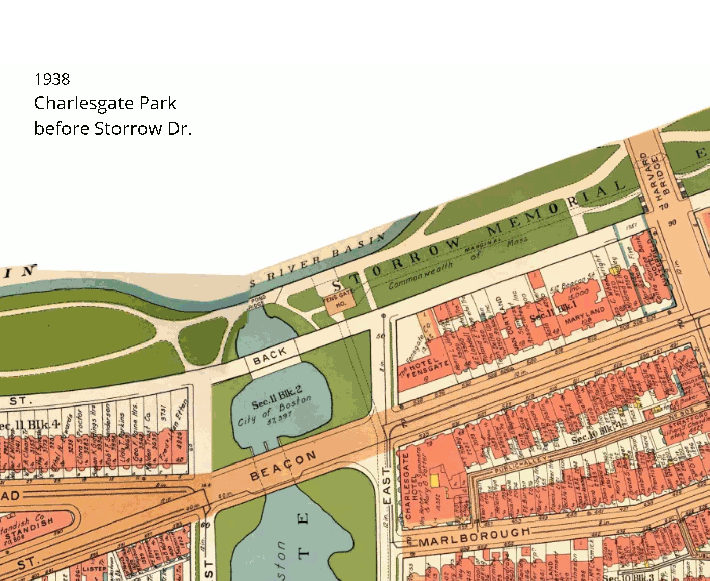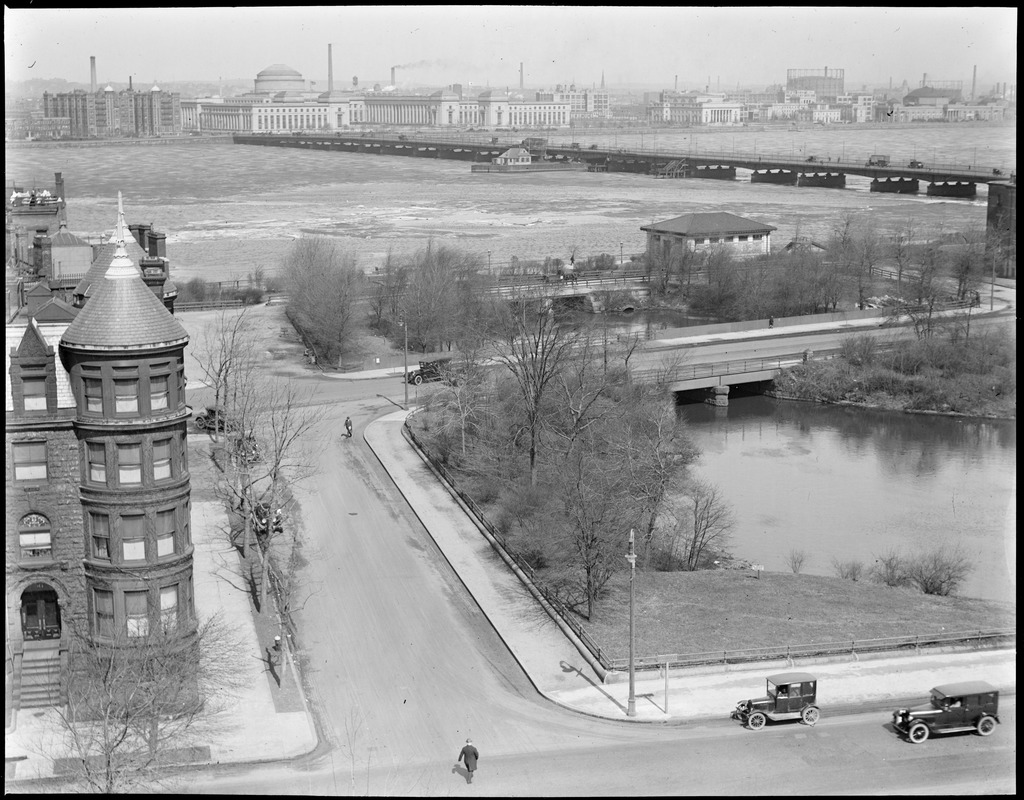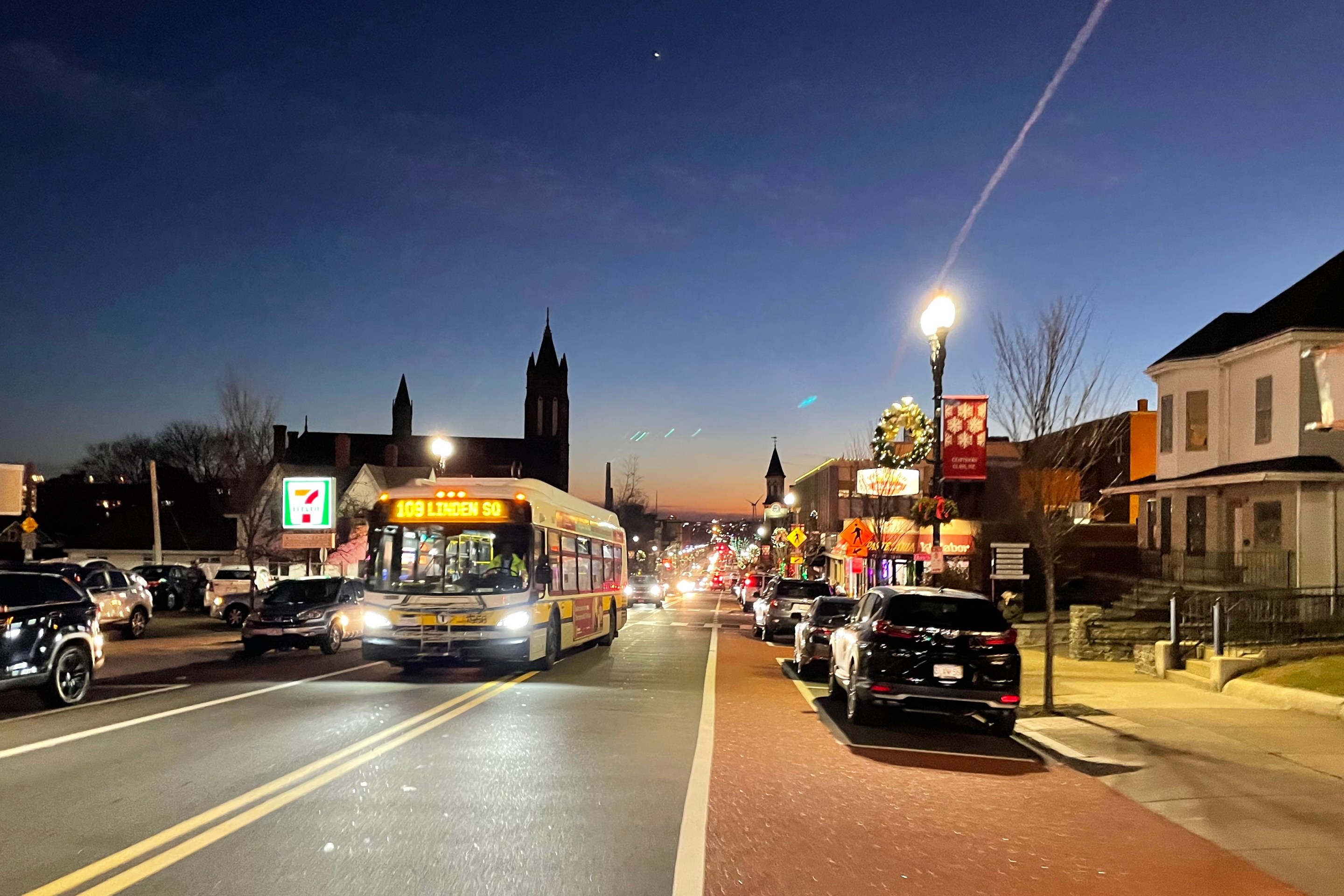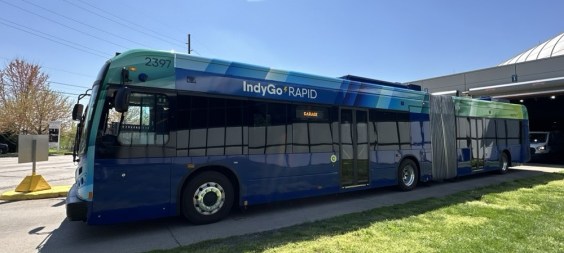
MassDOT recently committed to building two highway projects near Boston's Kenmore Square that would scale down the convoluted tangle of highway ramps around Storrow Drive and the Fenway and make room for a partial restoration of the historic parklands that once joined the Back Bay Fens and the Charles River.
But under the agency's current plans, the Bowker Overpass, the four-lane highway viaduct which effectively obliterated Boston's Charlesgate Park in the mid-1960s, will remain in place for at least another decade.
It’s difficult to imagine it today, but until the 1960s, Charlesgate (pictured above, around 1930) was a leafy riverbank park where the Muddy River emptied into the Charles. It wasn’t much different from the Riverway and Jamaicaway parks further upstream – and indeed, all those parks were designed by the nation’s most famous landscape architect, Frederick Law Olmsted.
At a time when the rest of Boston was was still busily burying wetlands to make more land for the growing city, Olmsted's design for the Emerald Necklace proposed that the city should instead preserve an inner-city watershed – the Muddy River and the Back Bay Fens – and build a linear park that could also reduce flooding and clean up the city’s polluted waterways.
Olmsted's vision survived until the 1950s, when the Metropolitan District Commission – the predecessor of today’s Department of Conservation and Recreation – started its notoriously destructive highway-building spree through Boston’s parklands.
Philip G. Bowker, a Brookline Republican and member of the Metropolitan Commission, led the charge to build Storrow Drive in the late 1940s and early 1950s (Storrow Drive was named in spite against James and Helen Storrow, the philanthropists who funded and championed the construction of the original car-free Charles River Esplanade in the early 20th century; Helen Storrow vigorously opposed the roadway until her death in the mid-1940s).
In the 1960s, the Commission followed up its destruction of the Charles riverfront with the Philip G. Bowker Overpass, the viaduct that obliterated Charlesgate Park and buried the mouth of the Muddy River in an underground pipe.
“The blunder we made in 1965”
It’s now 2022, and the southern part of the Bowker Overpass – the span over the Massachusetts Turnpike and the Worcester Line commuter rail tracks – is nearing the end of its lifespan.
Bowker and his ilk by now are long gone, and both the City of Boston and the state government have committed to reducing traffic in the years to come as a necessary step towards meeting ambitious climate goals.
Meanwhile, Olmsted’s original 19th-century vision for Fenway – letting a wetland park work as a tool to prevent floods and mitigate pollution – is back in demand as the city looks to expand its “green infrastructure.”
A 2015 research project by Northeastern University student Dixian Qui and civil engineering professor Peter Furth made the argument that the Bowker Overpass is unnecessary, even under traffic engineers’ traditional logic that prioritizes minimal amounts of delay for people in cars.
By extending the surface-level Charlesgate East and Charlesgate West streets, and shifting the Storrow outbound roadway away from the river, the Northeastern team found that MassDOT could maintain car access between the Fenway and Longwood areas on the historic street grid with acceptable “level of service” (the name for traffic engineers’ traditional, if widely criticized, measure of traffic congestion).
“We should make every effort to repudiate the blunder we made in 1965, turning Charlesgate Park into a highway wasteland,” the Northeastern team wrote.
Rebuilding the Bowker
In spite of that conclusion, MassDOT is doubling down on plans to keep the Bowker Overpass where it is over the course of two separate projects that would put the area under construction for most of the next decade.
The first project, scheduled to begin in 2024 and take two to three years to complete, would replace the southernmost portion of the Bowker Overpass between the Fenway and Commonwealth Avenue at a cost of $59 million.
The project would remove two on- and off-ramps that connect the viaduct to Commonwealth Avenue, and add a second, smaller overpass to the west, along the historic alignment of Charlesgate West, to carry local traffic plus a wide bike and pedestrian pathway.

A second, more ambitious $120 million project, whose construction would last four years beginning in 2027, would reconfigure the highway interchange where the Bowker Overpass meets Storrow Drive.
This project would remove some highway ramps and consolidate Storrow Drive traffic onto a new 4-lane bridge over a restored Muddy River, which would once again see the light of day as it flows into the Charles River after over half a century in an underground culvert.
By consolidating Storrow Drive traffic on a new bridge, the project would also create additional parkland along the riverfront, with new pathways and improved connections between the Esplanade, the Harvard Bridge, and Kenmore Square:

This design would also provide a major upgrade to the connection between the Harvard Bridge and the Esplanade's shared-use pathways. MassDOT plans to remove the hairpin-turn ramp that currently connects the Esplanade with the eastern sidewalk of the Harvard Bridge, and in its place, build new shared-use paths and a new crosswalk across Massachusetts Avenue to connect the Esplanade paths with both sides of the Harvard Bridge and its new protected bike lanes.
MassDOT has shown a willingness to tear down other 1960s-era highway viaducts in other projects over the past decade, such as its 2015 demolition of the Casey Overpass in Jamaica Plain and its planned teardown and road diet for the McGrath Highway. But the agency is not planning to take that approach with the Bowker.
“The majority of the Bowker Overpass structure will remain in place with minimal repairs,” explained Kristen Pennucci, a MassDOT spokesperson, in an email to StreetsblogMASS. “This structure had significant repairs to the deck about 10 years ago.”
Still, even though traffic will continue to roar overhead, there’s no doubt that MassDOT’s current plans would still represent a major improvement for Charlesgate Park and the Esplanade compared to the indignities those parks have suffered for the past half-century.
“We are really encouraged right now that pedestrian and bike access and improvements to stormwater and other things are included in the project,” Karen Mauney-Brodek, President of the Emerald Necklace Conservancy, told StreetsblogMASS last week. “For the first time in over 70 years we’ll be able to bike or walk between the Back Bay and the Esplanade.”
Mauney-Brodek also told StreetsblogMASS that plans are underway to provide a fully connected path through the middle of Charlesgate Park to connect the new trails that MassDOT is planning in its projects on the northern and southern ends of Charlesgate Park.
“It is absolutely the intention of the project that (the full path from Fenway to the riverfront) would be implemented at the same time, or a similar time (as the MassDOT projects). It all has to happen together and we’re working with all parties to ensure that it does,” she said.
“It’s an exciting thing to think about the ways we can use the rebuilding of gray infrastructure to achieve our green goals,” Mauney-Brodek continued. “These kinds of improvements are what Boston needs in order to provide different transportation and connectivity opportunities for people.”
Learn more:
View details of MassDOT's conceptual plans for the area here (PDF).






